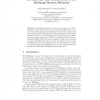Free Online Productivity Tools
i2Speak
i2Symbol
i2OCR
iTex2Img
iWeb2Print
iWeb2Shot
i2Type
iPdf2Split
iPdf2Merge
i2Bopomofo
i2Arabic
i2Style
i2Image
i2PDF
iLatex2Rtf
Sci2ools
APCSAC
2003
IEEE
2003
IEEE
L1 Cache and TLB Enhancements to the RAMpage Memory Hierarchy
The RAMpage hierarchy moves main memory up a level to replace the lowest-level cache by an equivalent-sized SRAM main memory, with a TLB caching page translations for that main memory. This paper illustrates how more aggressive components higher in the hierarchy increase the fraction of total execution time spent waiting for DRAM. For an instruction issue rate of 1 GHz, the simulated standard hierarchy waited for DRAM 10% of the time, increasing to 40% at an instruction issue rate of 8 GHz. For a larger L1 cache, the fraction of time waiting for DRAM was even higher. RAMpage with context switches on misses was able to hide almost all DRAM latency. A larger TLB was shown to increase the viable range of RAMpage SRAM page sizes.
| Added | 04 Jul 2010 |
| Updated | 04 Jul 2010 |
| Type | Conference |
| Year | 2003 |
| Where | APCSAC |
| Authors | Philip Machanick, Zunaid Patel |
Comments (0)

